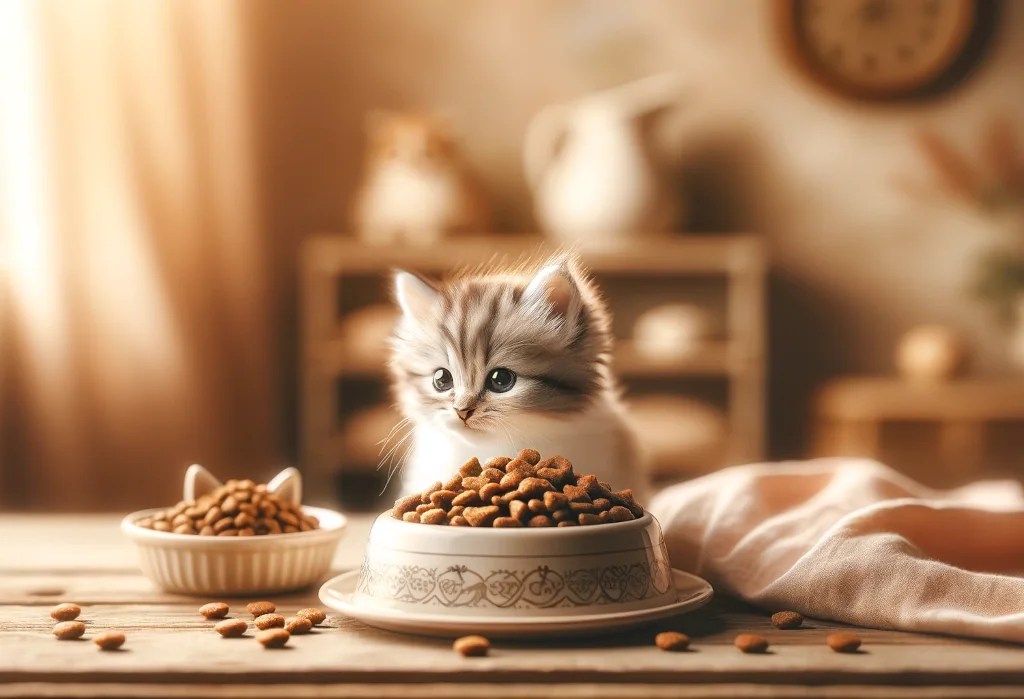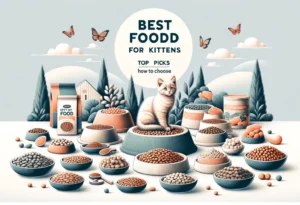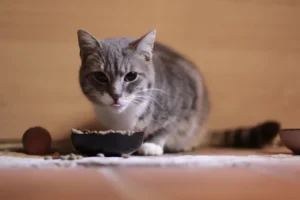Note: We may earn a commission from helpful, relevant links in our content. No cost to you. See our privacy policy.

Choosing the right food for your kitten feels a bit like trying to solve a Rubik’s cube that fights back, doesn’t it? One wrong move, and it’s not just the puzzle that’s upset. That’s why it’s crucial to arm yourself with knowledge to make the best choice for your furry bundle of energy and mischief.
By the end of this post, you’ll walk away with a clear understanding of what makes certain dry cat foods better for your kitten and feel confident in making a choice that will keep them healthy, happy, and growing.
Quick Takeaways:
- Choose kitten food with meat as the first ingredient and ensure it’s AAFCO certified for balanced growth.
- Feed kittens under 6 months 3-4 times a day; reduce to 2-3 times daily from 6-12 months.
- Start transitioning to adult food by mixing it with kitten food at about 10-12 months old.
What Does My Kitten Need Nutritionally?
When it comes to nurturing a growing kitten, understanding their nutritional needs is key.
Unlike adult cats, kittens require a diet rich in protein and fat to support their rapid growth and development. Imagine protein as the building blocks of your kitten’s muscles and fats as the fuel that keeps their tiny engines running. But it’s not just about protein and fat; kittens also need a balanced intake of vitamins and minerals to ensure healthy bone growth, vision development, and immune system function.
For instance, calcium and phosphorus are crucial for strong bones and teeth, while Vitamin A is essential for good vision. Another key nutrient, DHA (Docosahexaenoic Acid), an omega-3 fatty acid found in mother’s milk, is vital for brain development. So, it’s clear, nurturing your kitten with the right diet is the cornerstone of their healthy growth.
How to Read Kitten Food Labels Like a Pro
Diving into the world of kitten food labels doesn’t have to be a daunting task. Here’s a pro tip: focus on the first five ingredients listed on the label, as they make up the majority of the diet. High-quality kitten foods often start with a specified meat, meat byproduct, or seafood as the first ingredient, which signals a protein-rich diet.
Also, keep an eye out for AAFCO (Association of American Feed Control Officials) nutritional adequacy statements. If a dry cat food is labeled as “complete and balanced for growth,” it means it meets the nutritional levels established by the AAFCO for kittens.
Another tip is to look for food that includes specific nutrient content, such as DHA for brain development, and taurine, an essential amino acid. One unique recommendation – and something most might not know – is checking for probiotics listed among the ingredients. Probiotics in kitten food can support digestive health, ensuring your little furball absorbs all the nutrients they need efficiently.
The Top Picks for Dry Kitten Food
When it comes to selecting the best dry food for your kitten, I’ve got you covered with some top-notch recommendations. Here are a few that stand out not only for their quality ingredients but also for the love kittens seem to have for them:
-
Royal Canin Kitten Dry Cat Food : Specially formulated for kittens up to 12 months old, this food nails the balance between proteins, fats, and carbohydrates to support growth. It also boasts a blend of antioxidants, vitamins, and minerals tailored for a developing immune system.
-
Blue Buffalo Wilderness Kitten Chicken Recipe : High in protein with deboned chicken, this grain-free option is fantastic for providing your kitten with the energy they need. Plus, it includes “LifeSource Bits” – a precise blend of antioxidants, vitamins, and minerals.
-
Hill’s Science Diet Kitten Indoor Dry Cat Food : Perfect for indoor kittens, this food focuses on DHA from fish oil for brain development, high-quality protein for muscle growth, and a balanced set of minerals for strong bones and teeth.
What sets these options apart isn’t just the quality of ingredients; it’s also their dedication to meeting the unique nutritional needs of kittens. Whether it’s the inclusion of DHA, specific vitamins and minerals, or the right balance of protein and fats, these choices stand out in the crowded market of kitten food.
Remember, while choosing the best dry food for your kitten, always consider their individual taste preferences and dietary needs. These recommendations are a great starting point to ensure your kitten is on the path to a happy and healthy life.
Grain-Free vs. Grain-Inclusive: What’s Best for Your Kitten?
When it comes to choosing the best dry cat food for your kitten, the grain-free versus grain-inclusive debate can feel as tangled as a ball of yarn. Let’s unravel this topic to help you make an informed choice for your feline friend.
Grain-Free Diets often contain more meat-based protein and fewer carbohydrates, aligning closely with a cat’s natural carnivorous diet. They can be a godsend for kittens with grain allergies or sensitivities, alleviating symptoms like itching, digestive issues, or hair loss.
Pros:
– Higher in animal protein
– May reduce allergy symptoms
– Often highly palatable
Cons:
– Can be pricier than grain-inclusive options
– Not all grain-free diets are created equal; some may lack in nutritional balance
Grain-Inclusive Diets integrate grains like rice, barley, and oats, which can provide essential nutrients, including fiber, vitamins, and minerals. These diets support healthy digestion and are generally more affordable.
Pros:
– Cost-effective
– Balanced source of energy
– Beneficial for kittens without grain-related dietary sensitivities
Cons:
– Not suitable for kittens with grain allergies
– Some brands may use grains as “fillers”
Ultimately, the choice depends on your kitten’s health, dietary needs, and your veterinarian’s advice. A kitten with a grain allergy might thrive on a grain-free diet, while grain-inclusive food might be the ticket for those without sensitivities, offering a balanced blend of nutrients.
How Much and How Often Should I Feed My Kitten?
Kittens are like little balls of energy, constantly playing, growing, and, yes, eating. Getting their diet right is crucial during these formative months. Here’s a straightforward guide to feeding your tiny carnivore:
-
Up to 6 months old: Your kitten is in the peak growth phase. It’s recommended to feed 3-4 small meals a day. Dry food should be available at all times to support their need to nibble throughout the day.
-
6-12 months: You can start to reduce feeding to 2-3 times daily. Keep an eye on their growth and adjust portions as needed.
-
Portion Sizes: Follow the recommended serving sizes on the cat food packaging, but remember, these are guidelines. Each kitten’s needs may vary based on their activity level and growth rate.
-
Stay Hydrated: Always ensure fresh water is available, especially important for kittens primarily fed dry food.
Remember, overfeeding can lead to obesity, while underfeeding can impede growth. Watching your kitten’s weight and adjusting food intake accordingly is key.
Transitioning to Adult Cat Food: When and How?
As your kitten nears their first birthday, it’s time to think about transitioning to adult cat food. This is a pivotal step in supporting their health as they step into adulthood.
When to Start: The transition should ideally begin when your kitten is about 10-12 months old. This can vary with breed and size, so consult your vet for the perfect timing.
How to Introduce New Food: 1. Day 1-3: Mix 75% kitten food with 25% adult food 2. Day 4-6: Make it a 50/50 split between kitten and adult food 3. Day 7-9: Shift to 25% kitten food and 75% adult food 4. Day 10: Welcome to 100% adult food
Why It’s Important: Adult cat food is formulated to maintain healthy weight and support ongoing health, rather than the rapid growth phase of kittenhood. Transitioning too early or too late can affect their nutritional balance.
Unique Tip: Each kitten is an individual, and some may be picky eaters. To make the transition smoother, consider warming the food slightly or adding a bit of water to enhance the aroma and texture. Cats rely heavily on smell to enjoy their food, so this simple trick can make a world of difference.
Choosing the right food, understanding the quantity and frequency of feeding, and smoothly transitioning to adult food are critical steps in ensuring your kitten grows into a healthy, vibrant cat. Always consult with your vet to tailor these guidelines to your kitten’s specific needs.
Alex, a passionate animal lover, has experience in training and understanding animal behavior. As a proud pet parent to two dogs and three cats, he founded AnimalReport.net to share insights from animal experts and expand his knowledge of the animal kingdom.









